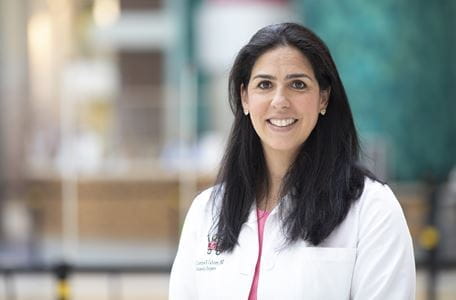Christine Caltoum, MD, has always had the drive and dedication of an athlete. She was a star tennis player all through high school and played Division 1 at the College of William and Mary. Tennis is what led her to orthopaedic surgery.
“Like many girls who end up in orthopaedics, I was in sports. My initial thought was that I was going to do sports medicine,” she explains.
Caltoum wanted to care for athletes with injuries. She was especially interested in surgery in sports medicine. During her third-year clerkship in medical school, she realized orthopaedic surgery was the best way to do that.
“But then I fell in love with taking care of kids,” Caltoum says, remembering an away rotation at Mayo Clinic, where she later completed her residency. “Once I did my second-year rotation in peds ortho, I was hooked.”
While completing residency, Caltoum was constantly reassured that this was the right path for her. “I have a very vivid memory from when I was a resident, taking care of this little girl who had a benign mass that we took out and how thankful her mother was. We closed her up with a very minimal scar. Taking care of that little girl cemented my going into pediatric orthopaedics.”
Caltoum, now an Assistant Professor of Clinical Orthopaedic Surgery and Division Cheif of Pediatric Orthopaedic Surgery, has made a name for herself in Indianapolis and Indiana. As a preeminent pediatric orthopaedic surgeon at Riley, she has cared for the state’s most complex trauma cases. She treats patients with severe breaks, infections and nearly fatal injuries that require quick, precise care.
One of the most traumatic cases Caltoum has worked on was a 12-year-old who suffered a severe break. As Caltoum recalls, it took multiple surgeries to repair the damage—but the rewarding nature of surgery was clear years afterward. “Several years later, her mom sent me a video of her doing gymnastics in college. She recovered quite well from her devastating injury.”
This is what Caltoum loves most about orthopaedic surgery: getting kids back to doing what they love after the most traumatic injuries. “When they really need you—when it’s a bad elbow fracture, and you put it back together, and the hand looks fine, and you have blood flow returning—those are the moments. Those are the moments that you say, ‘This is what I was meant to do.”
Overcoming challenges in medicine and orthopaedic surgery
Orthopaedic surgery is a highly specialized surgery subspecialty, and Caltoum knows many misconceptions come with it. “You don’t have to have big, brawny muscles” she shares. “In terms of physique, anyone can be highly successful in orthopaedics.”
Succeeding in orthopaedic surgery has more to do with personality and grit. “What matters is that we care about our patients and want them to get better. We like fixing things. We see something broken, we fix it. That’s a unifying thread in orthopaedics in general. We’re doers.”
Despite making a successful career for herself and helping countless kids recover from traumatic injuries and diseases, Caltoum has had to overcome her share of challenges. “I have two little girls. Managing a career and a home life is challenging as a mom. It’s really hard when you have conferences in the early morning and late-night calls. There’s plenty of mom guilt when I miss something.”
Caltoum manages these challenges with organization, which is something that she says has taken time and practice. “I’ve allowed myself to work a little bit less to make sure I get to the things I need to get to. Organization is key,” she shares.
Caltoum remembers going to her daughters’ school and asking for the calendar of important dates and events a year in advance. Although they thought she was overly zealous, it was important to Caltoum to get the information early. “I can be present for very important things, but there are some things I can’t be present for. I know the things I definitely don’t want to miss, and I let go of the other ones.”
What it means to be a Woman in Medicine
These challenges are not unique to Caltoum, or even to orthopaedic surgeons. Many women face a dual burden of caring for children while pursuing careers. This burden is especially challenging to navigate in medicine and contributed to why women were not represented as physicians for many years.
Fortunately, this is changing. “For many years now, women make up more than 50% of the incoming medical school classes. From that standpoint, women have done a great job, and we provide a lot of care,” she says. “We’ve always been caregivers, going back to nursing and Florence Nightingale. It’s a natural extension that we’ve become physicians and represent over 50% of medical schools.”
Despite these advances and the increasing presence of women in medical schools, women are not represented equally in all specialties. “The challenge has been for women to become more of a presence in some of the surgical subspecialties that have been harder to crack. Unfortunately, ortho is behind. We still sit at about 10%.”
For Caltoum, this is an opportunity for growth that cannot be missed. “As we enter Women in Medicine Month, we can be proud of where we’re at, but there’s still a lot of places we need to still go.”
This extends to leadership, too. “In orthopaedics, we are very rarely present in C-suite and Department Chair positions. Those are all areas we need to be. The more we’re there, the more we pave the way,” she says.
“Nothing should hold us back in terms of our ability to lead when it comes to those areas.”
